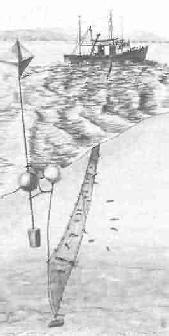|
http://www.ices.dk/reports/ace/2001/august01.pdf
Studies have estimated that the annual bycatch of
common dolphins in the Celtic Sea hake gill nets
fishery is of the order of 200.
There are no estimates available for the annual by
catch of dolphins in the Danish North Sea
gill nets fisheries, the UK North Sea gill nets fisheries,
or indeed for the other gill nets fisheries.
The true scale of cetacean bycatch in gill nets fisheries
is not known, as there is no compulsory monitoring
system of European fishing vessels and therefore
the true extent of cetacean bycatch is not known.
In the United States, the Marine Mammal Protection
Act requires that fishing vessels are monitored for
levels of marine mammal bycatch, and having
estimated the levels for each fishery, steps are taken
to reduce the cetacean bycatch levels.
When gill net fisheries in the Northwest Atlantic were monitored by US fisheries observers, it was found that a number of cetacean species were “incidentally captured” in gill nets: harbour porpoises, bottlenose dolphins, common dolphins, white-sided dolphins, white-beaked dolphins, orca, long-finned pilot whales, minke whales humpback whales and sperm whales.
http://www.nmfs.noaa.gov/prot_res/PR2/Stock_Assessment_Program/individual_sars.html
http://www.ices.dk/reports/ACE/2001/wgmmph01.pdf
It would therefore not seem too unreasonable to suggest that gill nets fisheries in the Northeast Atlantic, and other European waters, “incidentally capture” the same cetacean species.
http://europa.eu.int/comm/fisheries/doc_et_publ/liste_publi/studies/bycatch/contents.htm
Measures to Reduce Cetacean Bycatch in gill nets.
The methods most commonly tested for reducing cetacean
entanglement in gill nets have involved the attachment of
acoustic devices to nets – passive acoustic reflectors and
active acoustic devices “pingers”.
Passive Acoustic reflectors: The objective of placing
reflectors on gill nets is to enable cetaceans to “see” the net
as an impenetrable barrier.
However, many studies found reflectors to be ineffective,
and that further research was required.
Active Acoustic Devices (Pingers): Pingers are attached to
gill nets to make the nets “noisier”, thereby increasing the
likelihood of cetaceans echolocating around the nets.
Three types of pingers have been developed, Lien (US),
Dukane (US) and Pice (UK). Dukane and Pice pingers are
currently available.
Dukane have been in use since 1995, whereas Pice were developed
more recently.
The Dukane pinger has batteries which last 30 days,
whereas the batteries used in Pice pingers last for 12 months,
based on 6months submersion.
The Dukane pingers emit sounds every 4 seconds, whereas the
Pice emit sounds every 20 seconds.
The Dukane pinger is audible to humans, whereas the Pice is not.
Studies suggest that if the Dukane pingers are functioning correctly
and are correctly attached to gill nets, the bycatch of harbour porpoises
is reduced significantly at the beginning of a fishery.
Pingers are obligatory in Category 1 fisheries in the US, in
New Zealand fisheries in an attempt to protect the Hector’s
dolphin population, and the Danish Government is soon to
enforce their use in certain fisheries.
|


